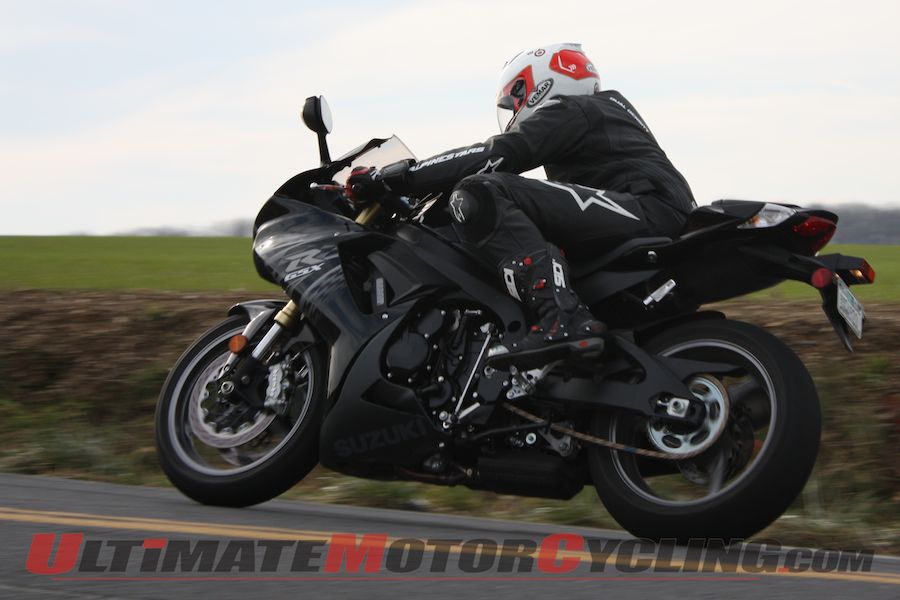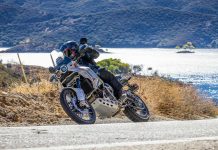2011 Suzuki GSX-R750 Review
We loved the updated 2011 Suzuki GSX-R750 on the track, but more so on the street. Here’s a look back at our review of this still-ruling mid-weight sportbike.
Leaned over, looking through a wide turn with not a tree, rock, fence or any other obstruction in sight, I felt the Alpinestars‘ left knee puck flat against the road.
The swoosh of noises varied as the puck scraped from the yellow line to blacktop and back while I constructed the most optimal line. And every time down this twist-filled stretch, the machine kept asking for more throttle…harder braking…more lean angle…
A realization began re-occurring – out of all the sportbikes I’ve piloted on the street, this newest version of Suzuki’s GSX-R750 was by far the easiest to “point” and “pull the trigger,” as my hero Scott Russell would say.
 This was the 2011 model, which received some heavy revisions over the previous year, making for a bolder platform that can take you places quick with much ease, all while remaining unbelievably comfortable by sportbike standards.
This was the 2011 model, which received some heavy revisions over the previous year, making for a bolder platform that can take you places quick with much ease, all while remaining unbelievably comfortable by sportbike standards.
These revisions included a shorter wheelbase, race-derived Showa suspension, optimal ergonomics, some weight shedding (419-pounds. wet!) and monster stopping power from the Brembo/Nissin setup.
And after two months of terrorizing the streets, this GSX-R750 proved itself over and over, especially on my personalized Mountain Course (one red light, six stop-signs, 50+ miles).
It all began with the first flick of the wrist. Well, maybe not the first. When I picked up the 2011 GSX-R from a local dealer with a whopping three miles on the odometer, the rearsets and suspension were set from the factory.
Within the first few feet, the mind was constructing bad thoughts about the Gixxer’s suspension and the ergonomics. But this quickly changed; once I arrive home, I tuned the suspension, but, more importantly, I moved the three-position adjustable rearsets down to their lowest setting, which made as much of a difference (or more) as the suspension setup.
 With minimal tweaking done, I was about to see what Suzuki accomplished with this revised sportbike. The most significant changes for 2011 arrived in the form of chassis refinement. Engineers created a more compact and lighter chassis through various innovations.
With minimal tweaking done, I was about to see what Suzuki accomplished with this revised sportbike. The most significant changes for 2011 arrived in the form of chassis refinement. Engineers created a more compact and lighter chassis through various innovations.
First, Suzuki rotated the inline-four rearward by three degrees around the countershaft sprocket, shortening the distance from the front-wheel axle to the swingarm pivot. This design helped shorten the wheelbase from 55.3 to 54.7 inches, said to ease steering changes, allowing riders to easily flick the bike in and out of corners with additional smoothness and quickness.
The shorter wheelbase also places more of the rider’s weight between the wheels, optimizing mass centralization, and shortens the length between the seat and handlebars. This shortened reach eases the repositioning of body weight for better handling as the rider switches sides while hanging off the Gixxer.
And when just cruising down the highway to get to a favorite canyon, the shorter reach adds much comfort over pre-2011 GSX-R 750s. Ride it…you’ll quickly see Suzuki was spot on with the mission of this redesign.
One thing that didn’t change over the earlier model was the relatively low seat height; it remains at 31.9 inches, but the profile is much slimmer. Due to this slimness, and the reshaped gas tank, I felt as if I was sitting inside the bike rather than on top of it. This created a sense of security, one that could mentally ease a rider into carving canyons a bit more quickly.
The other major enhancements that ease riding quickly arrive from the Showa suspension setup on the GSX-R; this is the first time a GSX-R750 arrived stock with Showa components.
The Suzuki features a race-derived, Showa Big Piston Front Fork (BPF), which doesn’t operate like a conventional inverted fork. The BPF “eliminates the separate internal cartridge assembly inserted into each fork leg and instead uses a single, 37.6 mm piston riding against the inside wall of the 41 mm inner fork tube,” according to Showa.
Technical jargon aside, these forks provide gobs of feedback while cornering and braking hard. And the other huge appeal of the Showa BPF is the ease of rebound and compression damping, which can be externally adjusted using a standard screwdriver and very audible clicks.
The 2011 GSX-R750 uses a Showa rear suspension that also features adjustable rebound and compression damping. The shock linkage system is lighter than the earlier model’s setup; this reduces unsprung weight, which equates to better traction while cornering.
The electronic-controlled steering damper rounds out the entire suspension package; it electronically adjusts to offer lighter damping at slower speeds and heavier damping at faster speeds. The damping changes are quickly noticed, especially at parking-lot speeds.
 Through the use of these suspension components, among others, and some further innovations when slimming down the chassis, the 2011 GSXR 750 weighs in at 419 lbs. wet, compared to 437 lbs. from the previous model.
Through the use of these suspension components, among others, and some further innovations when slimming down the chassis, the 2011 GSXR 750 weighs in at 419 lbs. wet, compared to 437 lbs. from the previous model.
The 2011 GSX-R 750’s engine also received some upgrades, although not nearly as drastic as the chassis refinements. Some improvements include revised camshaft profiles, and fine-spray eight-hole injectors for improved fuel atomization in the Suzuki Dual Throttle Valve (SDTV) fuel injection system. The 750’s engine performs just as it did in previous years, but with noticeably crisper throttle response.
Suzuki says the 2011’s engine was tuned for broader power delivery throughout the RPM range, and also a 10-percent better fuel mileage. I’d agree with the former, but the latter I couldn’t exactly comprehend, considering this bike was wide-open 80 percent of the time. One afternoon of serious sport riding, though, I was averaging around 40 mpg; this included about a 50/50 mix of highway cruising combined with backroad thrashing.
And like year’s past, there were no complaints of Suzuki’s gearbox. The six-speed transmission with vertically staggered shifts performed flawlessly. And when shifting, the gauge cluster features a gear indicator, a nice touch to any street machine.
A favorite revision arrived in electronics. For 2011, Suzuki used two modes instead of three in the Suzuki Drive Mode Selector (S-DMS). These two maps, A and B, can be switched on the fly.
The A mode is balls-out mode, with full power and acceleration, while the B mode is for moderate acceleration. The B mode was fun on some extremely tight sections of my Mountain Course, considering you could pin the throttle wide open in areas you would never think of doing so. It also provided additional security when rain spoiled an afternoon of fun on the twisties.
Then there’s the stopping power from the Brembo brakes, a set of 310mm discs up front squeezed by four-piston, monoblock calipers, and a 220mm disc squeezed by a single-piston Nissin caliper in the rear.
Once there’s some heat in the tires, this braking system out-performs anything ever placed on a GSX-R. The initial bite is there if needed, and there were many occasions when the rear tire would be completely off the ground. But the lever also allows a buildup of braking power, and will maintain desired pressure all while offering a light feeling on the lever.
 Besides performance that creates for easy riding, the GSX-R 750 has mounds of aesthetic appeal. From the layout of the gauge cluster to the smooth body lines that take the eye from the headlight (vaguely looks like a Dainese symbol!) to the skinny tail, the engineers at Suzuki once again created a sportbike that will surely please the eyes of many. And those mirrors containing blinkers? They are actually functional.
Besides performance that creates for easy riding, the GSX-R 750 has mounds of aesthetic appeal. From the layout of the gauge cluster to the smooth body lines that take the eye from the headlight (vaguely looks like a Dainese symbol!) to the skinny tail, the engineers at Suzuki once again created a sportbike that will surely please the eyes of many. And those mirrors containing blinkers? They are actually functional.
All said, after my two-month test aboard the 750, I arrived at a simple conclusion – strictly talking street credibility, Suzuki’s heavily revamped 2011 GSX-R750 is the optimal choice when choosing a sportbike, especially for the rider who enjoys spirited riding and doesn’t want to work too hard.
And again, this is strictly a street test. Others at Ultimate MotorCycling have proven the worth of the machine on the track. Although track days were possible with the GSX-R750, I wanted to focus 100-percent on streetability, something I’d argue 90 percent of riders would buy this machine for.
One more thing worth mentioning—Suzuki upgraded the 2011 GSX-R600 in similar fashion. But for the street rider, the 750 is offered at only $400 more for an MSRP of $11,999. The decision seems easy to make.
Oh, and the 2012 GSX-R750 is a carry-over model, except for new color offerings. So these words also speak for those shiny new models on the showroom floor, begging to be uncorked, and uncorked with ease.
Riding Style
- Helmet: Vemar Eclipse
- Jacket: Alpinestars GP Pro
- Pants: Alpinestars Apex
- Boots: Sidi Vortice
- Gloves: Joe Rocket Speedmaster 8.0
Photos by Jason Belz








![2023 KTM 390 Adventure Review [15 Fast Facts] 2023 KTM 390 Adventure Review: For Sale](https://ultimatemotorcycling.com/wp-content/uploads/2023/10/2023-ktm-390-adventure-review-24-218x150.webp)
![2023 Kawasaki KLR650 S ABS Review [15 Fast Facts]](https://ultimatemotorcycling.com/wp-content/uploads/2023/10/2023-kawasaki-klr650-s-review-dual-sport-adventure-motorcycle-14-218x150.webp)
